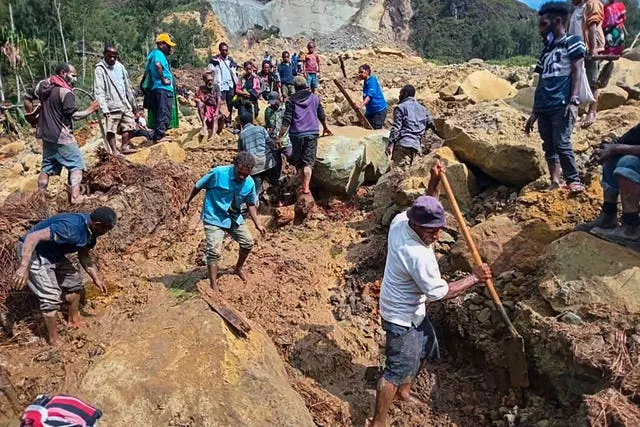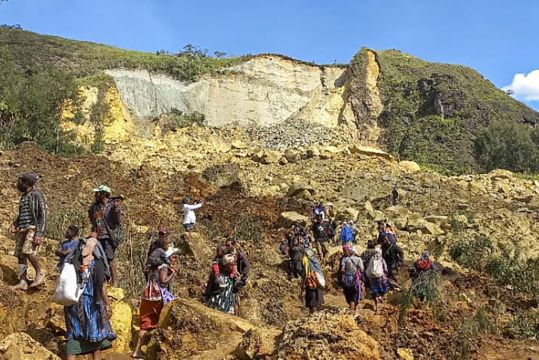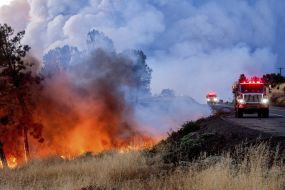Papua New Guinea has told the United Nations more than 2,000 people were believed to have been buried alive by Friday’s landslide and has formally asked for international help.
The government figure is roughly triple the UN estimate of 670 killed by the landslide in the South Pacific island nation’s mountainous interior. The remains of only six people had been recovered so far.
In a letter seen by The Associated Press to the United Nations resident co-ordinator dated Sunday, the acting director of the South Pacific island nation’s National Disaster Centre Lusete Laso Mana said the landslide “buried more than 2,000 people alive” and caused “major destruction”.
Estimates of the casualties have varied widely since the disaster occurred, and it was not immediately clear how officials arrived the number of people affected.
The International Organisation for Migration, which is working closely with the government and taking a leading role in the international response, has not changed its estimated death toll of 670 released on Sunday, pending new evidence.
“We are not able to dispute what the government suggests but we are not able to comment on it,” said Serhan Aktoprak, the chief of the UN migrant agency’s mission in Papua New Guinea.
“As time goes in such a massive undertaking, the number will remain fluid,” Mr Aktoprak added.
UN Secretary-General Antonio Guterres sent “heartfelt condolences” to the families of the victims, people and government of Papua New Guinea.
The intergovernmental organisation added that the UN and partners are supporting the government’s response efforts, with spokesperson Stephane Dujarric saying on Monday that the UN “stands ready to offer additional assistance at this challenging time.”
The death toll of 670 was based on calculations by Yambali village and Enga provincial officials that more than 150 homes had been buried by the landslide. The previous estimate had been 60 homes.
The office of Papua New Guinea Prime Minister James Marape did not respond on Monday to a request for an explanation of what the government estimate of 2,000 was based on. Mr Marape has promised to release information about the scale of the destruction and loss of life when it becomes available.
Determining the scale of the disaster is difficult because of challenging conditions on the ground including the village’s remote location, a lack of telecommunications and tribal warfare throughout the province which means international relief workers and aid convoys require military escorts.
At least 26 tribal warriors and mercenaries were killed in a battle between two warring tribes in Enga in February, as well as an unconfirmed number of bystanders.
The national government’s lack of reliable census data also adds to the challenges of determining how many are potentially dead.

The government estimates Papua New Guinea’s population at around 10 million people, although a UN study, based on data including satellite photographs of roof tops, estimated in 2022 it could be as high as 17 million. An accurate census has not been held in the nation in decades.
Mr Mana said the landslide would have a major economic impact on the entire country.
“The situation remains unstable” due to the shifting ground, “posing ongoing danger to both the rescue teams and survivors alike,” Mr Mana wrote to the United Nations.
An excavator donated by a local builder on Sunday became the first piece of heavy earth-moving machinery brought in to help villagers who have been digging with shovels and farming tools to find bodies. Working around the still-shifting debris is treacherous.

Mr Mana and Papua New Guinea’s defence minister, Billy Joseph, flew on Sunday in an Australian military helicopter from the capital of Port Moresby to Yambali to gain a first-hand perspective of what is needed.
Mr Mana’s office posted a photo of him at Yambali handing a local official a cheque for 500,000 kina (£102,000) to buy emergency supplies for the 4,000 displaced survivors.
The purpose of the visit was to decide whether Papua New Guinea’s government needed to officially request more international support.
Earth-moving equipment used by Papua New Guinea’s military was being transported to the disaster scene 250 miles from the east coast city of Lae.
Traumatised villagers are divided over whether heavy machinery should be allowed to dig up and potentially further damage the bodies of their buried relatives, officials said.







